قسم الكيمياء الحيوية
المزيد ...حول قسم الكيمياء الحيوية
حقائق حول قسم الكيمياء الحيوية
نفتخر بما نقدمه للمجتمع والعالم
30
المنشورات العلمية
6
هيئة التدريس
0
الطلبة
0
الخريجون
من يعمل بـقسم الكيمياء الحيوية
يوجد بـقسم الكيمياء الحيوية أكثر من 6 عضو هيئة تدريس

أ.د. عبدالله مسعود بشين بشين
عبدالله بشين هو احد اعضاء هيئة التدريس بقسم الكيمياء الحيوية بكلية الطب البشري. يعمل السيد عبدالله بشين بجامعة طرابلس كـأستاذ منذ 2007-04-15 وله العديد من المنشورات العلمية في مجال تخصصه





